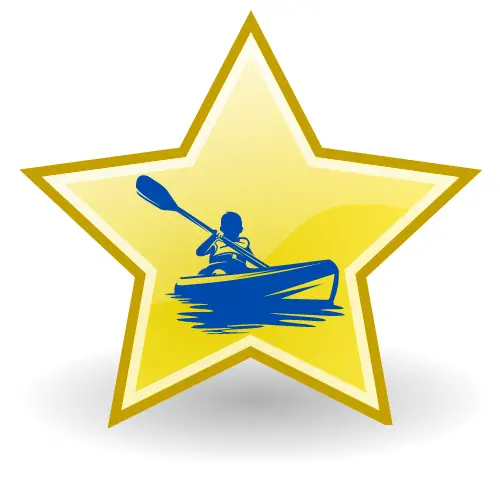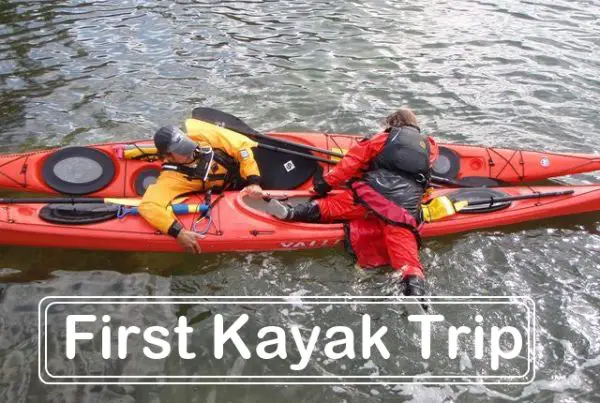You are already determined to go kayaking and you have chosen your kayaking route. But before you start paddling, determine which hand is right and which is left. This is no joke at all. The trouble with correctly identifying the body is quite common and occurs, for example, in people with crossed lateralization. It also takes them a little longer to learn movements that require coordination of both sides of the body and also cooperation with another person – which is important when rowing.
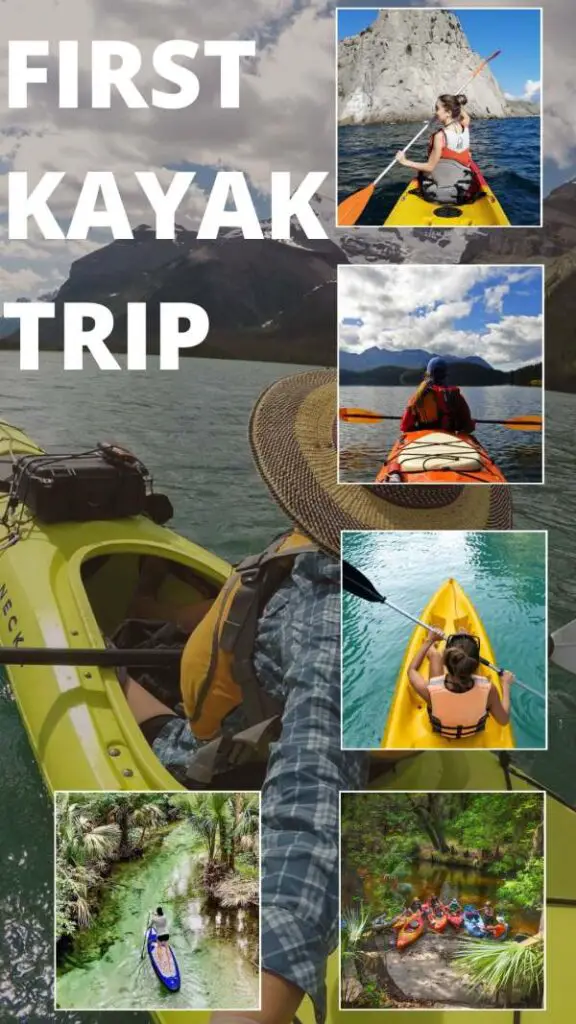
Therefore, once you decide to go rafting, learn more about the technical issues related to kayaking. Proper paddling techniques and watching the water will ensure that your rafting trip is safe.
Table of Contents
How to properly board a kayak
Remember not to get into a kayak that is partially standing on the shore. The kayak will be unstable, easily swaying from side to side. You could damage it or cause it to capsize right at the start.
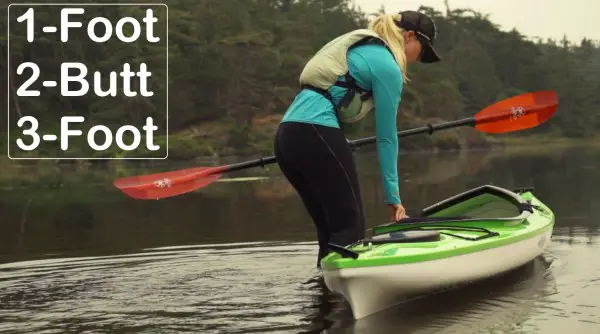
The easiest way to get into the kayak is to paddle on the bottom (that’s why in the text What to bring to the rafting trip we recommend taking sports shoes to the water). Set the kayak on the water, along the river bank, with the bow against the current. The first person to get in is the one sitting at the back because he/she will be steering the kayak. The second person holds the kayak, and when his/her companion/companion is already seated, he/she can start boarding.
To board, lower your body’s center of gravity slightly and grab the side of the cockpit with your hands. Use your right hand on the right side and your left hand on the left side. This way you will stabilize the kayak. Slide one leg in, putting it in the middle of the kayak, on its axis. Then sit on the seat, and put the other leg over the side of the kayak.
You can also help yourself with the paddle by placing it across the cockpit, at the front of the cockpit. Leaning forward, grasp the paddle and the cockpit rim on the left and right sides simultaneously with your hands. Next, insert one leg into the kayak, sit on the seat, and bring the other leg inside.
First Kayak Trip – Holding the oar correctly
Correct paddling technique is the basis for safe canoeing. It also makes the canoeing trip a pleasant relaxation and not a burden for the body.
To make paddling as effortless as possible, it is important to do it the right way. Start by gripping the paddle properly. Spread your arms and lift the paddle above your head. If you hold it correctly, a right angle is formed between your left and right forearms. You should maintain the same forearm position while rowing.
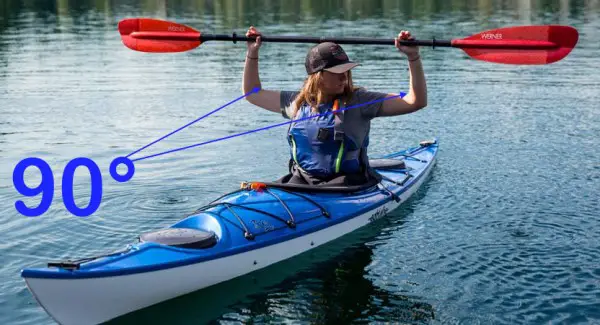
The choice of paddling technique depends on the type of water you are paddling. In our entry, we’ll focus on lakes and rivers – because these are the routes we support in Kajaki Sękowski rentals.
First kayak trip on the lake
For inexperienced people, swimming even on a smooth lake can be a challenge. This is where the ability to swim straight ahead will be most useful. On a river, it is also useful, but to a much lesser extent.
When you get into the kayak on the lake shore, you will feel the moment when the water starts to lift the boat. Then start paddling. On a lake (Hemlock and Canadice) try to keep the bow of the kayak perpendicular to the line of the waves, not parallel.
Sail straight ahead, pulling the paddle from the bow to the back (stern) of the kayak. Stronger paddling on one side is sufficient to give direction. On a large body of water, it is important that these strokes are even, steady, and possibly with a slight correction. When swimming straight ahead, it is not only the arms that propel the canoe – the whole torso also helps. Pay attention, however, that the center of gravity of the body does not lean out beyond the outline of the boat. Remember, that the kayak loaded with equipment is also more difficult to steer.
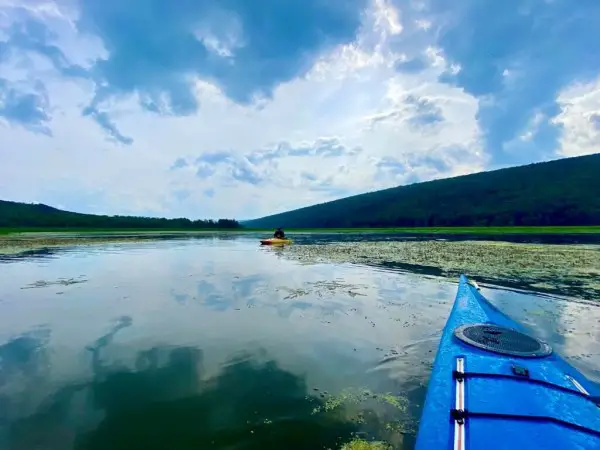
After finishing your float on the lake, bring the bow of the kayak perpendicular to the shore, efficiently lower the kayak and quickly pull it onto the sand.
First kayak trip on the river
When you are kayaking down a river, you will need mainly the technique of counteracting and stopping the kayak – the opposite of what you need on a lake. Here, the current carries the boat by itself (e.g. on a canoeing trip from Borsk), so what you need to focus on is avoiding obstacles or fast braking.
Contouring is pulling the paddle from the back of the kayak to the front (bow). If, for example, you want to quickly turn right, avoiding a stone or a lying tree branch, you contour from the right. Put the paddle blade deep into the water and make an even arc. The more force you use, the more efficiently you will make the turn. The paddle blade should be positioned so that it engulfs the water toward the kayak.
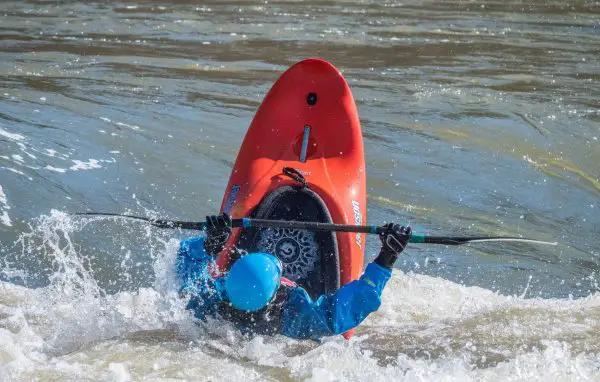
Using this technique alternately and quickly (once from the right, once from the left) you can stop the kayak. This will be useful in a situation when you notice an obstacle too late and want to avoid collision with it.
By the way – the river current, bypassing the obstacle, usually forms a V shape. The blade of the letter V indicates the location of the obstacle. The arrangement of currents on the surface of the river is a reflection of the shape of the bottom, the location of obstacles, and the outline of the bank. Therefore, it is worth watching it very carefully.
When you finish rafting on the river, make a 180-degree turn. Then approach the shore slowly and parallel (not straight ahead).
Easy routes for beginners and instructor assistance
Kayak paddling routes that are suitable for beginners and families with children should be relaxed and without obstacles. These are low-lying rivers with wide beds, shallow bottoms, and calm currents. There are plenty of places to stop on the banks of rivers – even if you make a mistake and your kayak flips over, you can easily get to shore, pour out the water and continue on your way.

In the case of a large group of novice kayakers, you can additionally get instructions at the rental points on how to hold the paddles, get on and off the kayak, as well as how to jump up, and swim to shore properly. This will help the group get used to kayaking, relieve stress, and acquire the basic technical skills needed for your first kayak trip.
If you need more information about paddling and kayaking techniques, we would be happy to provide you with additional information.
FAQ
Is it hard to kayak for the first time?
Kayaking for the first time can be both exciting and, at times, challenging, but it’s generally not overly difficult. Your experience will depend on several factors, including the type of kayak, water conditions, your fitness level, and your comfort in the water. Here are some things to consider:
Stability: Sit-on-top kayaks are often recommended for beginners because they are more stable and easier to re-enter if you capsize. This can make the experience less intimidating.
Water Conditions: Starting in calm and sheltered waters, such as a calm lake or slow-moving river, is advisable. These conditions are more forgiving for beginners.
Paddle Technique: Learning and practicing proper paddle technique is important for efficiency and control. An introductory kayaking lesson can be very helpful in this regard.
Physical Fitness: While you don’t need to be an athlete to kayak, a reasonable level of fitness can make the experience more comfortable. Paddling involves using upper body muscles, so having some arm and core strength can be beneficial.
Safety Precautions: Always wear a properly fitting personal flotation device (PFD) and consider taking a lesson or going out with an experienced kayaker for your first time to ensure you’re following safety guidelines.
Enjoy the Scenery: Kayaking is not just about physical effort; it’s also about enjoying the scenery and being in touch with nature. Take breaks to relax and appreciate your surroundings.
Be Patient: Understand that it’s normal to feel a bit unstable or unsure when you first start. As you gain experience, your confidence and comfort on the water will grow.
While kayaking for the first time may have a learning curve, it’s a rewarding and accessible outdoor activity that can be enjoyed by people of various skill levels. As you gain experience and familiarity with the equipment and techniques, kayaking can become a fun and enjoyable pastime.
What is the first rule of kayaking?
The first rule of kayaking is typically referred to as the “safety first” rule. This rule emphasizes the importance of prioritizing safety while kayaking. Here are some key aspects of the first rule of kayaking:
Safety First: Always make safety your top priority. Before every kayaking outing, ensure that you have the necessary safety equipment, including a properly fitting personal flotation device (PFD), signaling devices, and other essential gear. Check the weather and water conditions, and be prepared for emergencies.
Skill and Knowledge: Learn and practice proper kayaking techniques and safety procedures. This includes how to paddle effectively, how to re-enter your kayak after a capsize, and how to respond to various on-water situations.
Environmental Awareness: Respect the environment and wildlife. Minimize your impact on the ecosystem, avoid disturbing wildlife, and practice responsible environmental stewardship.
Hydration and Nutrition: Stay hydrated and fuel your body with adequate nutrition during your kayaking trip. Dehydration and lack of energy can affect your well-being on the water.
Communication: Keep communication open with fellow kayakers or paddling partners. Discuss your plans, stay in visual or vocal contact, and be prepared to assist others in case of emergencies.
The “safety first” rule sets the foundation for responsible and enjoyable kayaking. Prioritizing safety not only minimizes risks but also enhances the overall experience on the water.
Is it safe to kayak with no experience?
Kayaking without any experience can be safe if you follow certain guidelines and take appropriate precautions. Here are some important considerations for kayaking with no experience:
Take a Lesson: Consider taking a kayaking lesson from a certified instructor. Lessons provide valuable guidance on paddling techniques, safety procedures, and rescue skills.
Start in Calm Waters: Begin your kayaking journey in calm and sheltered waters, such as a calm lake or slow-moving river. These conditions are more forgiving for beginners.
Use a Stable Kayak: Choose a stable and beginner-friendly kayak. Sit-on-top kayaks are often recommended for novice paddlers because they are more stable and easier to re-enter in case of a capsize.
Wear a PFD: Always wear a properly fitting personal flotation device (PFD) while kayaking. It provides buoyancy and safety.
Inform Others: Let someone on shore know about your kayaking plans, including your intended route and expected return time. This is a safety precaution in case of emergencies.
Stay Close to Shore: Stay near the shoreline and avoid venturing too far from safety points on your initial outings.
Practice Self-Rescue: Learn and practice self-rescue techniques, such as how to re-enter your kayak after a capsize. These skills can boost your confidence and safety.
Check Weather Conditions: Before heading out, check weather conditions and forecasts. Avoid kayaking in adverse weather, especially strong winds and storms.
Stay Hydrated: Bring water and stay hydrated during your trip.
Paddle with a Buddy: It’s safer to kayak with a partner, especially as a beginner. Paddling with someone else provides assistance and support.
While it’s possible to kayak safely with no experience, taking lessons and starting in easy conditions will help you learn the fundamentals and build your skills gradually. As you gain experience and confidence, you can explore more challenging environments and longer distances. Safety, knowledge, and proper equipment are key to a positive kayaking experience, especially for beginners.
How many miles should a beginner kayak?
The number of miles a beginner should kayak in one outing can vary based on several factors, including the beginner’s physical fitness, experience, the type of kayak, and the water conditions. Here are some general guidelines:
Short Distances: For complete beginners, it’s recommended to start with shorter trips, typically ranging from 1 to 5 miles. This allows newcomers to become accustomed to the kayak, practice paddling techniques, and build their stamina.
Recreational Kayaking: If you’re new to kayaking but in relatively good physical shape, you can comfortably paddle 5 to 10 miles for a day trip. Recreational kayaking is a good option for beginners as it often involves calmer and more sheltered waters.
Skill Development: It’s important for beginners to focus on skill development and gradually increase the distance they paddle. Starting with shorter distances and then progressing to longer trips as skills and confidence grow is a wise approach.
Water Conditions: Consider the water conditions. Calm lakes or slow-moving rivers are more forgiving for beginners, while paddling in strong currents, wind, or waves requires more experience.
Breaks and Rest: Plan for breaks during longer trips to rest, hydrate, and stretch. Taking regular breaks can make longer outings more enjoyable and less tiring.
Remember that safety and comfort are paramount, especially for beginners. It’s essential to choose an appropriate distance that aligns with your fitness level and experience. As you gain experience and confidence, you can gradually extend the distance of your kayaking outings. Always prioritize safety and enjoy the journey at your own pace.
What are four mistakes in kayaking?
Four common mistakes in kayaking that can lead to safety issues and less enjoyable experiences are:
Inadequate Safety Precautions: Neglecting safety measures is a significant mistake. This includes not wearing a personal flotation device (PFD), not carrying essential safety gear, or not having a proper float plan. Failing to prioritize safety can lead to dangerous situations.
Overestimating Skills: Some kayakers make the mistake of attempting advanced conditions or challenging routes without the necessary skills and experience. Overestimating your abilities can lead to accidents, capsizes, or getting stranded.
Ignoring Environmental Impact: Disregarding environmental ethics is another mistake. This includes littering, disturbing wildlife, or not following Leave No Trace principles. Such behavior harms the environment and can lead to legal consequences. It’s essential to respect nature and minimize your impact.
Lack of Proper Gear and Clothing: Not having adequate clothing or equipment is a mistake that can lead to discomfort and even hypothermia in cold conditions. Always dress appropriately and carry essential gear, including a PFD, paddle leash, and dry bags for your belongings.
Avoiding these mistakes and continuously improving your kayaking knowledge and skills will contribute to a safer and more enjoyable kayaking experience.
What is the proper etiquette for kayaking?
Proper etiquette while kayaking ensures a safe and enjoyable experience for yourself and others on the water. Here are some key etiquette guidelines for kayaking:
Respect the Environment:
Follow Leave No Trace principles by not disturbing wildlife, avoiding trampling on sensitive shorelines, and packing out all trash and litter.
Do not harm or harass marine life, including birds and seals. Keep a respectful distance.
Share the Water:
Be aware of other water users, such as swimmers, paddleboarders, and boaters. Give them space and avoid collisions.
Yield the right of way to larger vessels, and be cautious when crossing shipping lanes.
Follow Local Regulations:
Observe local rules, regulations, and guidelines specific to the area where you’re kayaking. This includes no-wake zones, restricted areas, and safety requirements.
Paddle Safely:
Wear a personal flotation device (PFD) at all times and ensure it’s properly fitted.
Follow safe paddling techniques and be mindful of your surroundings, especially in busy or narrow waterways.
Use navigation lights and signaling devices if paddling in low-light conditions.
Keep Noise Levels Down:
Keep noise to a minimum to avoid disturbing wildlife and other paddlers. Enjoy the serene beauty of nature.
Stay Informed:
Stay informed about weather conditions and water forecasts before heading out. Be prepared for changing conditions.
Share Your Float Plan:
Inform someone on shore about your planned route and expected return time. This is a safety precaution in case of emergencies.
Practice Self-Rescue Skills:
Learn and practice self-rescue techniques, such as re-entering your kayak after a capsize, to ensure your safety.
Help Others in Need:
If you encounter other paddlers in distress, provide assistance if safe to do so. Alert authorities or other help if necessary.
Be Courteous:
Be courteous and friendly to fellow kayakers and water enthusiasts. Share a friendly wave or greeting when appropriate.
Minimize Your Impact:
Minimize your environmental impact by using eco-friendly sunscreen, avoiding unnecessary engine use, and respecting no-wake zones.
Proper kayaking etiquette promotes safety, environmental conservation, and a positive experience for everyone sharing the water. Always prioritize responsible and respectful behavior while enjoying the great outdoors.
What should you not do while kayaking?
While kayaking, there are several important things you should not do to ensure your safety and a enjoyable experience:
Paddle Without a Personal Flotation Device (PFD): Always wear a properly fitting PFD while kayaking. It provides buoyancy and can save your life in case of a capsize.
Ignore Weather Conditions: Do not disregard weather forecasts. Check weather conditions before heading out, and avoid kayaking in adverse conditions like thunderstorms or strong winds.
Exceed Your Skill Level: Do not attempt waters or conditions beyond your skill level. Start with suitable environments for your experience and gradually progress to more challenging waters.
Paddle Alone in Remote Areas: Avoid kayaking alone in remote or unfamiliar areas. Having a paddling partner is safer in case of emergencies.
Overload the Kayak: Do not exceed the weight limit or load the kayak unevenly. Overloading can affect stability and safety.
Lose Sight of Your Location: Do not lose track of your position. Always know your location, plan your route, and recognize landmarks and navigation points.
Neglect Sun Protection: Do not forget to protect yourself from the sun. Wear sunscreen, a hat, and sunglasses to prevent sunburn and glare.
Disturb Wildlife: Do not disturb wildlife. Maintain a respectful distance to avoid causing stress or harm to animals.
Venture Without a Plan: Do not paddle without a float plan. Always inform someone about your trip, route, and expected return time.
Panic in a Capsize: Do not panic if you capsize. Stay calm, follow safety procedures, and know how to re-enter your kayak.
Litter or Pollute: Do not litter in the water. Dispose of trash properly and follow Leave No Trace principles to protect the environment.
Disregard Local Regulations: Do not ignore local kayaking regulations or guidelines, including safety requirements, restricted areas, and speed limits.
By avoiding these actions while kayaking, you can ensure your safety, minimize your impact on the environment, and enjoy a rewarding paddling experience. Always prioritize safety and responsible enjoyment of the water.
What not to do in a kayak?
To ensure your safety and enjoyment while kayaking, here are some important “what not to do” guidelines:
Overload the Kayak: Do not exceed the weight limit or load your kayak unevenly. Overloading can affect stability and buoyancy.
Neglect Safety Gear: Do not paddle without essential safety gear, including a personal flotation device (PFD), a whistle, and signaling devices.
Forget to Check the Weather: Do not ignore weather forecasts. Always check weather conditions and be prepared for changes on the water.
Ignore Water Conditions: Do not paddle in water conditions beyond your skill level. Strong currents, high winds, and challenging waves can be dangerous if you’re not prepared.
Disregard Your Skill Level: Do not attempt kayaking in advanced conditions if you lack the necessary skills and experience. Start with suitable environments for your ability.
Neglect Sun Protection: Do not forget to protect yourself from the sun. Wear sunscreen, a hat, and sunglasses to prevent sunburn and glare.
Lose Track of Your Position: Do not lose track of your position. Always know your location and plan your route, including recognizing landmarks and navigation points.
Paddle Alone in Remote Areas: Do not paddle alone in remote or unfamiliar areas. It’s safer to have a paddling partner in case of emergencies.
Litter or Pollute: Do not litter in the water. Respect the environment by disposing of trash properly and following Leave No Trace principles.
Disregard Wildlife: Do not disturb wildlife. Maintain a respectful distance from animals to avoid causing stress or harm to them.
Neglect Hydration: Do not forget to bring water and stay hydrated during your trip.
Skip Safety Training: Do not neglect safety training. Learn and practice self-rescue techniques, as well as how to respond to emergencies.
Venture Without a Plan: Do not paddle without a float plan. Always inform someone about your trip, route, and expected return time.
Panic in a Capsize: Do not panic if you capsize. Stay calm, follow safety procedures, and remember how to re-enter your kayak.
Ignore Local Regulations: Do not ignore local kayaking regulations or guidelines, such as no-wake zones, restricted areas, or specific safety requirements.
By adhering to these “what not to do” principles, you can enhance your safety, protect the environment, and make the most of your kayaking experiences. Remember to prioritize safety, respect nature, and enjoy the adventure responsibly.
How likely is it to tip over in a kayak?
The likelihood of tipping over in a kayak depends on several factors, including your skill level, the type of kayak, water conditions, and your actions on the water. Here are some considerations:
Skill Level: Novice kayakers are more likely to tip over compared to experienced kayakers. Proper training and practice can significantly reduce the risk of capsizing.
Kayak Type: Different kayaks have varying levels of stability. Wide and flat-bottomed kayaks are more stable, while narrower, sleeker kayaks are less stable but offer better performance. Sit-on-top kayaks tend to be more stable and are often chosen by beginners.
Water Conditions: Calm and sheltered waters are less likely to cause capsizing. In contrast, challenging conditions like strong winds, waves, and fast currents increase the risk of tipping over.
Paddling Technique: Proper paddling technique and body positioning can help maintain stability. Overreaching, leaning too far, or erratic paddling can make tipping more likely.
Loading and Weight Distribution: Loading your kayak unevenly or exceeding the weight limit can affect stability and increase the risk of capsizing.
Obstacles and Collisions: Colliding with underwater obstacles or other watercraft can lead to tipping over.
Self-Rescue Skills: Knowing how to perform self-rescue techniques, like re-entering your kayak after a capsize, can minimize the consequences of tipping over.
Safety Precautions: Wearing a personal flotation device (PFD) and other safety gear, such as a spray skirt in a sit-inside kayak, can enhance safety.
In general, with proper training, suitable equipment, and good judgment, kayaking is a safe and enjoyable activity. The likelihood of tipping over can be minimized by gaining experience, choosing the right kayak for your skill level, and being aware of water conditions. If you’re new to kayaking or paddling in challenging environments, consider taking lessons and following safety guidelines to reduce the risk of capsizing.
Is it hard to kayak for 3 hours?
The difficulty of kayaking for 3 hours depends on various factors, including your fitness level, experience, the type of kayak, the water conditions, and your chosen route. Here are some considerations:
Fitness Level: If you’re physically fit and have experience kayaking, paddling for 3 hours might be relatively easy. Regular upper body strength and stamina can make it more manageable.
Experience: Novice kayakers may find extended periods of paddling more challenging. Experience helps with efficient paddling technique, reducing fatigue.
Type of Kayak: A more efficient and comfortable kayak, such as a sea kayak or touring kayak, can make long trips easier. These kayaks are designed for extended paddling and often have features like comfortable seats and storage for gear and supplies.
Water Conditions: Calm and sheltered waters are generally easier for extended paddling. Challenging conditions like strong winds, waves, or currents can increase the physical effort required.
Rest Breaks: Plan rest breaks during the 3-hour trip to stretch, hydrate, and rest. This can make the experience more enjoyable and reduce fatigue.
Pace: Paddling at a sustainable pace rather than pushing too hard can help you maintain energy and avoid exhaustion.
In general, many people can kayak for 3 hours without significant difficulty, especially in favorable conditions. However, it’s important to be mindful of your physical condition, monitor your energy levels, and take breaks as needed. If you’re new to kayaking or embarking on a longer trip, it’s a good idea to start with shorter outings and gradually build up your endurance. Additionally, proper hydration, nutrition, and sunscreen are essential for comfort and safety during extended kayaking trips.
Our best posts:
